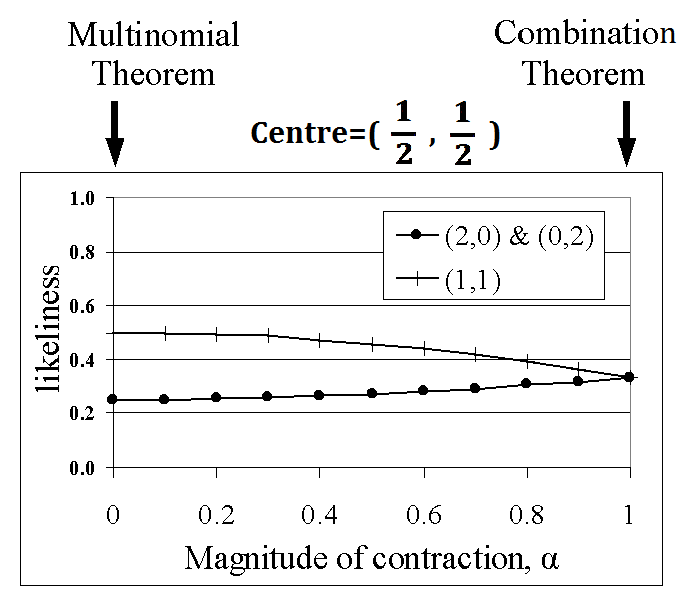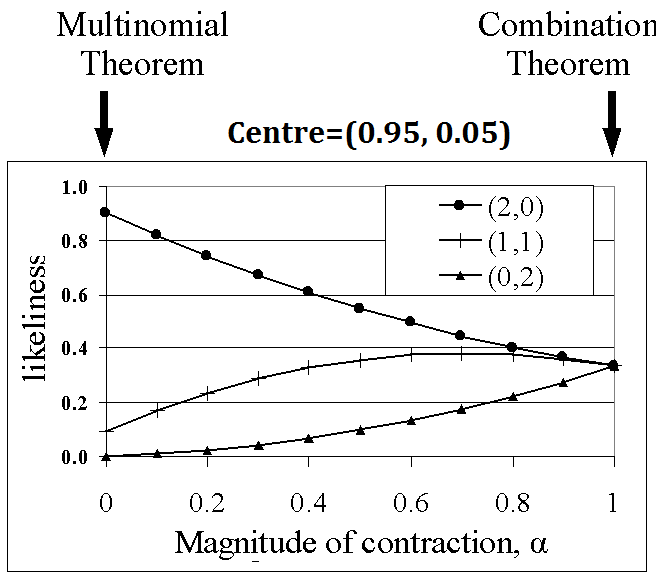Lovegrove Mathematicals
"Dedicated to making Likelinesses the entity of prime interest"
Lovegrove Mathematicals
"Dedicated to making Likelinesses the entity of prime interest"
Because we are all familiar with them, and because they are so simple, problems about coins are very common in introductory texts about probability.
The difficulty with this is that people are so familiar with everyday coins that they invariably overlook the need to define their mathematical terms: they don't actually say what a coin is so far as their analysis is concerned. As a result, they struggle with problems which -if they were to think about definitions- would be obvious or, at any rate, obviously badly-stated.
Just as importantly, as the whole raison d'être of mathematical coins is that they be tossed, what do we mean by "tossing" a coin?
This page introduces my own view of sensible definitions and then investigates them further.
For our purposes, a coin is any element of S(2).That is, it is a pair of strictly positive numbers summing to 1, eg. (0.6, 0.4), (0.01, 0.99) etc. [ S(2) is the open-ended straight line segment joining (1,0) and (0,1) ] By convention, we use the labels ("H","T") rather than ("1","2").
A 'toss' of the coin f is defined algorithmically.
We use the computer's RANDOM function to select a number in ]0,1].

The probability of "H", given f, is the likeliness over the singleton set {f} of "H". This is f(1), so the probability of "H" is f(1), and the probability of "T" is f(2).
The coin f is biased towards H if f(1)>½, ie. if f(1)>f(2). It is biased towards T if f(2)>½, ie. if f(2)>f(1). A coin is biased if it is biased towards H or biased towards T.

Since the fair coin is the only coin which is not biased
Reminder: a probability is a likeliness over a singleton set
| Number of tosses | Number of H | ||||
| 0 | 1 | 2 | 3 | ||
| 0 | 1 | ||||
| 1 | 1 | 1 | |||
| 2 | 1 | 2 | 1 | ||
| 3 | 1 | 3 | 3 | 1 | |
If the underlying set is the singleton set {f} and g is some integram then the likeliness of g is a probability and is given by using the Multinomial Theorem as M(g)fg. If f is the fair coin, we use Pascal's triangle to display the relative proportions of the likelinesses (probabilities) of the various integrams (see left).
| Number of tosses | Number of H | ||||
| 0 | 1 | 2 | 3 | ||
| 0 | 1 | ||||
| 1 | 1 | 1 | |||
| 2 | 1 | 1 | 1 | ||
| 3 | 1 | 1 | 1 | 1 | |
If the underlying set is S(2) then the likeliness of g given 0 is obtained from the Combination Theorem. We use another triangle to display the relative proportions of the likelinesses of the various integrams (see right).
If we are modelling a minted coin then we need to use an underlying set (centred on the fair coin) with a small diameter. To do this, we use a contraction of S(2) centred on the fair coin. Since we do not know which diameter (magnitude) to use, we shall consider a range of values.
If we use a magnitude of 0 then the underlying set becomes {(½, ½)} and the Multinomial Theorem applies. If we use a magnitude of 1 then the underlying set remains as S(2) and the Combination Theorem applies. By varying the magnitude of the contraction from 0 to 1, we can observe the transition from the Multinomial Theorem to the Combination Theorem.
In the diagram below, we are modelling two tosses of a coin, so there are three possible results: (2,0), (0,2) and (1,1). Notice how the curves remain almost horizontal for magnitudes less than about 0.3. This means that in practice it would be very difficult to detect bias within the limits (0.35,0.65) by using two tosses: the limits, here, are 0.5±0.3*0.5.

If we are not trying to model a minted coin then we do not need to centre on the fair coin. In the next diagram, the centre is (0.95,0.05). Notice how the likeliness of (1,1) reaches a maximum at a contraction of magnitude about 0.7, ie not at either end.

In both diagrams, the three curves meet at the value ⅓. Calculations were carried out using my program Great Likelinesses.
What do children have to do with coins? They ARE coins. To be precise, they are tosses of the fair coin.
We represent the outputs by the symbols ("boy","girl") rather than ("H","T") or ("1","2").
The gender of a child is determined by tossing the fair coin once. Two or more tosses give the genders of the appropriate number of children: the first toss is the eldest child, the last toss is the youngest, and so on.
Since the set of fair coins is singleton, we may refer to 'probabilities'.
The following two questions are (arguably) the same question:
Of course, we are here talking about mathematical children. Whether real children are equivalent to mathematical children is another matter. There are two reasons why they might not be:
The situation is much the same as with minted coins. It's just that we don't call them minted children and we do have a significant amount of real-life data.
The whole subject of mathematical children can become very complex, very quickly. For a discussion of some of the points, see the Wikipedia article Boy or Girl Paradox
Go to Dice or to